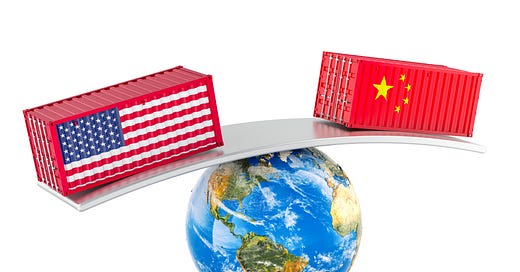How China and the US could both win from the trade war
“I have repeatedly said Chinese people’s rice bowls should be firmly held in our own hands, never let others take us by the throat on eating, which is a basic survival issue.”
This quote was Xi Jinping in 2021 in the middle of the pandemic, who was expressing concern about securing food supplies. But there was also concern about securing supplies of minerals and energy.
And this theme of self-sufficiency goes back further. In 2015, a policy dubbed “Made in China 2025” sought to significantly reduce China’s dependence on foreign core technologies, and at the same time build China into an industrial powerhouse.
So, while the world watched stunned as Trump revealed his list of tariffs on his so-called “Liberation Day”, China wasted little time in striking back with its own retaliatory tariffs. China has been preparing for this moment.
Some observers have suggested that China has more leverage in this trade war – for instance, they could buy soybeans from Brazil instead of the US.
But let’s not forget that China’s economy would be affected significantly. The $600 billion worth of exports annually to the US cannot be diverted easily - the rest of the world cannot readily absorb it. Grinding exports to the US to a halt would lop off a sizeable chunk off GDP, and without additional stimulus measures, economic growth for this year could be somewhere between 3 and 4% rather than 5% that authorities have targeted.
Of course, given the importance of the growth target to Chinese authorities aren’t going to sit on their hands and let growth slow that significantly.
So, just what are some of the measures that Chinese authorities could take to mitigate the impact of the trade war?
One course of action that some observers have suggested could be to allow the yuan to devalue. However, there are a couple of issues with devaluation. Firstly, even a substantial devaluation could only partially offset 100%+ tariffs. And secondly, a purposeful devaluation of the yuan comes with a risk of capital flight. As financial markets anticipate a devaluation, investors sell the yuan to prevent losses accelerating capital outflows.
As a side note, yuan devaluation is in complete contradiction to selling US treasuries. China can’t simultaneously force a devaluation of the yuan and sell US treasuries, as China has to buy foreign currency – namely the US dollar, if it wants to keep the yuan lower than the market otherwise suggests. That also means that selling US treasuries would put upward pressure on the yuan, which would hurt its own export sector further. It would be a bit of an own goal for China, especially during a trade war.
But the Chinese also have other tools to boost the economy.
They could increase investment spending, which has been the Chinese government’s tried and tested way to support the economy when it has faced tough times. But, as regular readers of this newsletter would know, there are increasing limits to relying on investment as a source of stimulus. There’s only so much road and rail that China needs, although there’s still a lot to be spent on new power stations and huge focus on investing in the industrial sector.
Finally, China could increase stimulus for the consumer. Supporting the consumer is the most obvious area for stimulus, given the long-running dependence on investment and industry for growth. In fact, it has been Chinese households which has in a way lost out due to China’s longstanding industrial policy. The more incomes are diverted towards industry subsidies or spending on government projects, the smaller the proportion of incomes go to consumers.
Notice how tariffs, another form of industrial policy, similarly diverts incomes away from consumers to support America’s export sector.
But in China’s case, long running industrial policy has contributed to much more production than it consumes. China must export that additional production, thereby resulting in China’s massive trade surplus.
If China were to successfully let its consumers take a larger proportion of incomes and boost domestic demand, that would reduce China’s trade surplus as consumption would increase relative to its production. And if China’s surplus declines, then deficits elsewhere around the world would also have to decline – which means the US deficit would most likely decline too.
It’s actually beneficial for China to reduce its trade surplus, and in the past six months, authorities have been expressing a greater willingness to provide support to consumer. The tragedy is that beyond all the bluster and conflict, China and the US should have mutually beneficial goals.
In a rational world, the US trade team could potentially negotiate a faster transition for China to prioritize support its consumer, and less on industrial subsidies. Of course, whether China would do what the US wants, even if it works out in the interest of the Chinese people is another story. And the rhetoric out of the US suggests little understanding of these dynamics.
Regardless, whether China is forced to turn to stimulus due to Trump’s tariffs and trade uncertainty or if the US and the world manages to convince China to reduce industrial subsidies, it does seem that the big winner in all of this could be the Chinese consumer.
******************************************************************************************************
If you like this, and would like to see more insights do subscribe. And to show additional support I would be extremely thankful if you become a paid subscriber:
Alternatively, you can provide a one-off donation through my buymeacoffee link.
https://buymeacoffee.com/januchanD
All contributions are much appreciated! Thank you to all who have subscribed, shared and donated.




